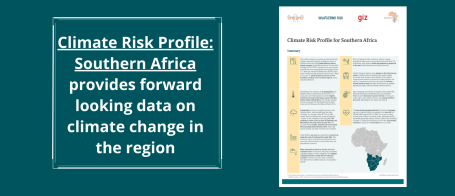Climate Risk Profile: Southern Africa
Dowload the full climate risk profile here.
Rising temperatures, changing precipitation patterns and more extreme weather events as a result of climate change pose existential challenges to Southern Africa. For millions of people across the region, climate impacts and related losses and damages will be felt in various sectors, including water, agriculture, infrastructure, ecosystems and human health.
The climate models presented in the Climate Risk Profile: Southern Africa project that under a medium- to high-emissions scenario, air temperature will very likely increase by up to 4.1 °C by 2080, compared to pre-industrial levels. Although air temperature increases will affect the entire region, their magnitude will vary: The highest temperature increases are projected for Botswana, eastern Namibia and the north of South Africa. Temperature increases in coastal areas will be comparatively smaller.
Precipitation trends are uncertain and vary across Southern Africa, indicating different directions of change. For example, the southwest, centre as well as most of Zimbabwe and Mozambique are projected to become drier. On the other hand, Lesotho, Eswatini and eastern South Africa are projected to become wetter. Future dry and wet periods are likely to become more extreme. Due to these changing climatic conditions, ecosystems, biodiversity and crop production will largely decrease, with the exception of yields of cassava, groundnuts, maize and rice which are projected to benefit from CO2 fertilisation. At the same time, per capita water availability for Southern Africa is projected to decline under both the low- and the medium- to high-emissions scenario. This decline is not primarily driven by climate change, but rather by socio-economic factors. These factors include population growth, along with increased agricultural production, leading to increased water abstraction for irrigation, drinking water, domestic use and hydropower generation.
Reliable climate impact data, as presented in the Climate Risk Profile: Southern Africa, can enhance capacity for action and improve operational responses towards a more climate-resilient and peaceful future. If complimented with localised human security data and intersectional conflict analysis, this data can be used by project partners and policy planners in the region to integrate climate adaptation strategies in order to support risk-informed decision making.
The climate projections presented in the Climate Risk Profile: Southern Africa are the product of a collaboration between Weathering Risk and the AGRICA project at PIK. It draws on the methodology developed within the AGRICA project.
Disclaimer: The Climate Risk Profile for Southern Africa was originally published by PIK. All rights reserved.
Share on


